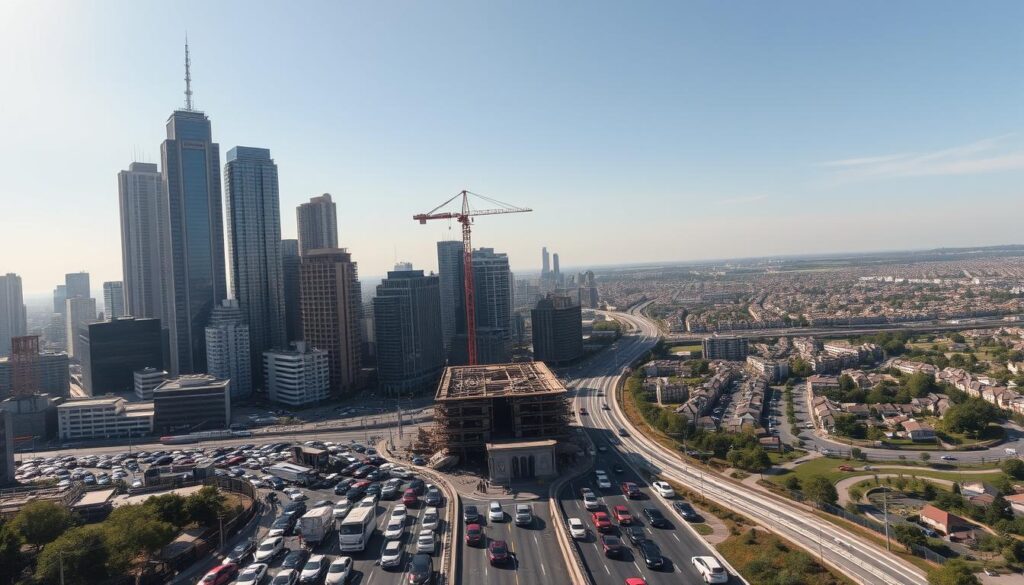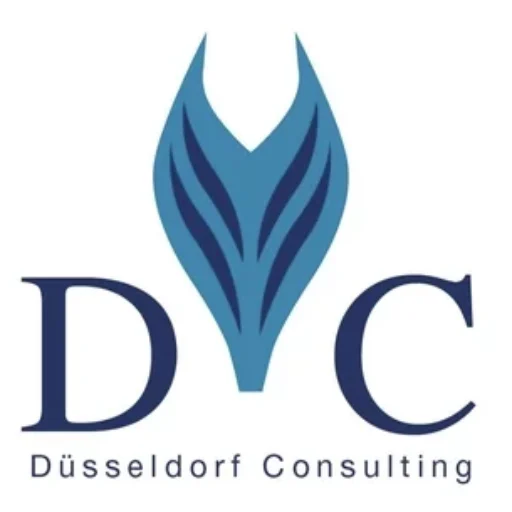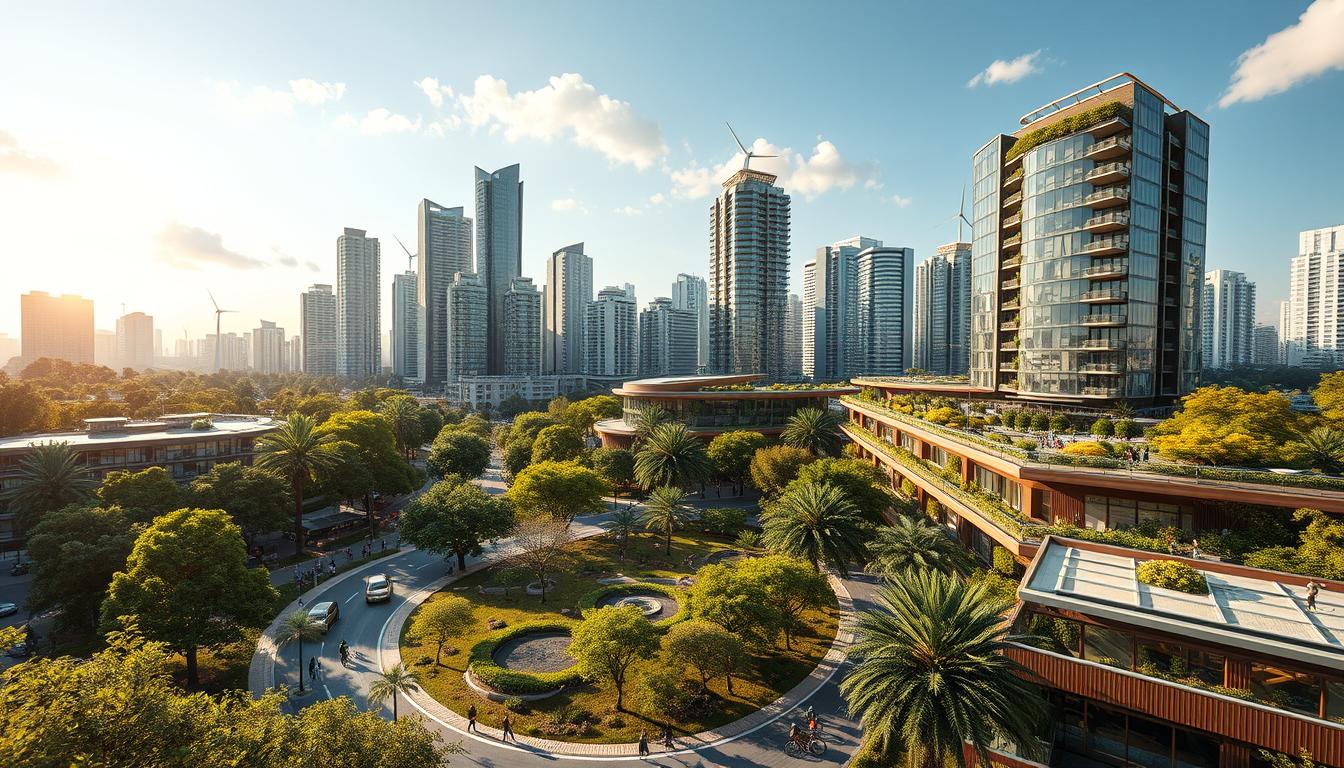Eco-friendly city planning is a crucial aspect of modern urbanization, and Germany has been at the forefront of this movement.
Düsseldorf Consulting GmbH, located on Königsallee in Düsseldorf, is a testament to the city’s commitment to sustainable practices. The company’s motto, “ACTA NON VERBA !,” reflects the importance of action in achieving sustainability goals.
Germany’s initiatives range from green building practices to sustainable transportation solutions, making it an ideal case study for green infrastructure initiatives.
Key Takeaways
- Eco-friendly city planning is crucial for modern urbanization.
- Düsseldorf Consulting GmbH is a leader in sustainable practices.
- Germany’s green building practices are a model for sustainable development.
- Sustainable transportation solutions are key to reducing urban pollution.
- Green infrastructure initiatives are vital for urban sustainability.
Overview of Sustainable Urban Development in Germany
The German government has been at the forefront of promoting sustainable urban development through various initiatives and policies. This approach encompasses a broad range of strategies, from incorporating renewable energy in urban areas to promoting eco-friendly transportation systems.
One of the key aspects of sustainable urban development in Germany is the integration of renewable energy sources into urban planning. This includes the use of solar energy, wind power, and geothermal energy to reduce reliance on fossil fuels and decrease carbon emissions.
Sustainable transportation solutions are another critical component. Germany has been investing heavily in developing efficient public transportation systems, including electric buses and trains, to reduce urban air pollution.
| Aspect | Description | Benefits |
|---|---|---|
| Renewable Energy | Integration of solar, wind, and geothermal energy | Reduced carbon emissions, decreased reliance on fossil fuels |
| Sustainable Transportation | Electric buses and trains, enhanced public transport | Lower urban air pollution, improved quality of life |
| Environmentally Conscious Design | Green infrastructure, eco-friendly building practices | Enhanced biodiversity, improved urban ecosystems |
The focus on environmentally conscious urban design has led to the development of green infrastructure, including parks, green roofs, and urban gardens. These initiatives not only enhance biodiversity but also contribute to a healthier urban environment.
In conclusion, Germany’s approach to sustainable urban development is comprehensive, addressing energy, transportation, and urban design. By continuing to innovate and implement sustainable practices, Germany sets a precedent for other countries to follow.
Regulatory Framework and Policies
The regulatory framework in Germany plays a crucial role in promoting sustainable urban development through various national and local policies. Germany’s federal and state governments have enacted legislation supporting sustainability, including the German Federal Building Code, which mandates consideration of climate protection in zoning plans.
The German Federal Building Code is a key piece of legislation that promotes climate protection and sustainable building practices. It ensures that urban development projects are designed with consideration for environmental impact, thereby supporting green building practices.
Climate-friendly urban policies are integral to Germany’s approach to sustainable urban development. These policies encourage the use of renewable energy sources, reduce carbon emissions, and promote energy-efficient buildings.
Sustainable community development is another critical aspect of Germany’s regulatory framework. It involves creating communities that are not only environmentally sustainable but also socially equitable and economically viable.
Green Building Practices in Urban Areas
Green building practices are becoming increasingly prevalent in German urban development, offering numerous benefits. The shift towards eco-friendly construction methods is not only reducing the environmental impact of urban areas but also improving the quality of life for residents.
One of the key aspects of green building practices is the use of sustainable materials. Sustainable materials are sourced and used in ways that minimize environmental harm. Examples include reclaimed wood, low-carbon concrete, and insulation made from recycled materials.
The benefits of green building practices extend beyond environmental sustainability. They also include improved occupant health and productivity. For instance, buildings designed with natural light and ventilation can enhance the well-being of occupants.
Key Features of Green Buildings
- Energy-efficient systems
- Sustainable materials
- Water conservation systems
- Improved indoor air quality
According to a report by the German Sustainable Building Council, “Green buildings are not just environmentally friendly; they are also economically viable and socially responsible.” This underscores the multifaceted benefits of adopting green building practices in urban areas.
“The future of urban development lies in sustainable practices. By integrating green building techniques, we can create cities that are not only environmentally friendly but also livable and prosperous.”
| Green Building Feature | Environmental Benefit | Economic Benefit |
|---|---|---|
| Energy-efficient systems | Reduced carbon footprint | Lower energy costs |
| Sustainable materials | Less environmental degradation | Potential for cost savings |
| Water conservation systems | Reduced water consumption | Lower water bills |
In conclusion, green building practices are crucial for sustainable urban development in Germany. By adopting eco-friendly construction methods and materials, cities can reduce their environmental impact while improving the quality of life for their residents.
Urban Mobility and Transportation
Urban mobility in Germany is undergoing a significant transformation, driven by a focus on sustainability. The country has made substantial investments in public transport, electric mobility, and bicycle infrastructure, reducing reliance on fossil fuels and decreasing emissions.
Sustainable transportation solutions are being implemented across various cities, enhancing the quality of urban life. Germany’s approach includes promoting the use of electric vehicles, improving public transportation systems, and developing extensive bicycle networks.
Environmentally conscious urban design plays a crucial role in shaping urban mobility. Cities are being redesigned to prioritize green spaces, pedestrian areas, and efficient public transport systems, contributing to a healthier environment and reduced carbon footprint.
The integration of renewable energy in urban areas is further supporting sustainable urban mobility. Solar-powered charging stations and green energy-powered public transport are becoming increasingly common, reducing the dependency on non-renewable energy sources.
- Enhanced public transport systems
- Increased adoption of electric vehicles
- Expansion of bicycle infrastructure
These initiatives are part of a broader strategy to create more livable and sustainable cities in Germany. By focusing on sustainable transportation and urban mobility, Germany is setting a precedent for other countries to follow.
Energy Efficiency in Urban Planning
As part of its commitment to sustainable urban development, Germany has been at the forefront of incorporating energy-efficient practices into urban planning. The country has made significant strides in integrating renewable energy sources into its urban landscapes, reducing reliance on fossil fuels and lowering carbon emissions.
One of the key strategies employed by Germany is the implementation of energy-efficient building regulations. These regulations ensure that new constructions and renovations meet high standards of energy efficiency, thereby reducing overall energy consumption. For instance, buildings are now designed with better insulation, energy-efficient windows, and advanced heating systems, all contributing to a more sustainable urban environment.
The role of smart grid technology is also pivotal in Germany’s energy-efficient urban planning. Smart grids enable the efficient distribution and management of energy, allowing for real-time monitoring and adjustment of energy supply and demand. This not only enhances the reliability of the energy supply but also optimizes energy usage, reducing waste and improving overall efficiency.
Germany’s approach to energy efficiency in urban planning is further detailed in reports such as the one published by the Umweltbundesamt, which highlights the country’s integrated approach to urban and energy-efficient development. Additionally, investments in Germany’s residential construction sector, as discussed on Duscons, underscore the strategic benefits of focusing on energy efficiency.
By combining these strategies, Germany is setting a precedent for sustainable urban development, demonstrating that energy efficiency can be achieved through a combination of regulatory measures, technological innovation, and strategic investment.
Community Engagement in Urban Development
The success of urban development projects in Germany is often attributed to the level of community engagement and stakeholder participation. By involving residents and other stakeholders in the planning process, cities can ensure that projects meet the needs of the community and promote a sense of ownership.
Community engagement is not just about informing the public; it’s about creating a dialogue that fosters collaboration and mutual understanding. This can be achieved through various means, such as public meetings, workshops, and online platforms.

Effective stakeholder participation involves identifying and engaging with various groups, including local businesses, community organizations, and residents. This helps in understanding the diverse needs and expectations of the community.
Benefits of Community Engagement
- Increased trust and transparency in urban development projects
- Better alignment of projects with community needs
- Enhanced sense of community ownership
- More effective and sustainable urban development outcomes
The following table highlights some key strategies for enhancing community engagement in urban development:
| Strategy | Description | Benefits |
|---|---|---|
| Public Meetings | Regular meetings to inform and involve the community | Increased transparency, community feedback |
| Workshops | Interactive sessions to gather input and ideas | Collaborative problem-solving, community engagement |
| Online Platforms | Digital tools for continuous community engagement | Broad reach, convenience, ongoing feedback |
By adopting these strategies, cities in Germany can promote sustainable community development and ensure that urban development projects are successful and sustainable in the long term.
The Role of Technology in Sustainable Urban Development
Sustainable urban development in Germany is being driven by innovations in data-driven urban planning and waste management. The integration of technology in urban planning is crucial for creating smart cities that are not only efficient but also environmentally friendly.
One of the key aspects of data-driven urban planning is the use of advanced data analytics to understand and manage urban systems better. This includes analyzing traffic patterns, energy consumption, and waste management needs to optimize city operations.
Smart cities leverage technology to improve the quality of life for their citizens. This includes implementing smart grids for energy distribution, intelligent transportation systems, and advanced waste management systems. For instance, smart waste management systems use sensors to monitor waste levels in real-time, optimizing collection routes and reducing waste disposal costs.
Innovations in waste management are also playing a significant role. Technologies such as waste-to-energy conversion and advanced recycling facilities are being adopted to minimize landfill waste and reduce the environmental impact of waste disposal.
The benefits of these technological innovations are multifaceted:
- Improved efficiency in city operations
- Enhanced quality of life for citizens
- Reduced environmental impact through optimized resource use
- Increased sustainability through the adoption of renewable energy sources
As Germany continues to urbanize, the role of technology in sustainable urban development will become increasingly important. By embracing data-driven urban planning and waste management innovations, cities can become more livable, efficient, and sustainable.
Case Studies of Successful Sustainable Cities
The success stories of sustainable cities in Germany offer valuable insights into effective green spaces and urban mobility strategies. Cities like Freiburg, Hamburg, and Berlin have pioneered sustainable development practices, setting a benchmark for eco-friendly city planning.
Freiburg, known for its commitment to environmental sustainability, has become a model for eco-friendly urban development. The city’s approach to integrating green spaces into its urban fabric is particularly noteworthy. Freiburg’s Vauban district is a prime example, featuring car-free zones and energy-efficient housing.
Berlin, on the other hand, has made significant strides in revitalizing its urban spaces. The city’s green spaces, such as the Tempelhofer Feld, provide not only recreational areas but also contribute to the city’s biodiversity and climate resilience.
Key Features of Sustainable Cities in Germany
- Integration of green spaces into urban planning
- Innovative approaches to urban mobility, including bike-friendly infrastructure
- Energy-efficient buildings and renewable energy sources
- Community engagement in urban development projects
Hamburg’s sustainable urban development initiatives also highlight the importance of community engagement. The city’s participatory budgeting process allows citizens to have a say in how municipal funds are spent, ensuring that development projects align with community needs.
These case studies demonstrate that sustainable urban development is achievable through a combination of innovative planning, community involvement, and a commitment to environmental stewardship. As Germany continues to evolve its urban landscapes, the lessons learned from these cities will be invaluable.
Challenges Facing Sustainable Urban Development
Economic, social, and environmental challenges are hindering the progress of sustainable urban development in Germany. Despite the country’s significant efforts to adopt sustainable practices, several barriers remain.
Economic Barriers pose a significant challenge. The high upfront costs associated with green technologies and sustainable building practices can be prohibitive for many developers and municipalities. For instance, the cost of implementing energy-efficient systems or renewable energy sources can be substantial, making it difficult for some cities to justify the expense.

In addition to economic challenges, social equity is another critical issue. Sustainable urban development must ensure that all segments of society benefit from new developments. However, gentrification and rising housing costs can displace long-time residents, particularly in urban areas undergoing revitalization. Ensuring that sustainable development is inclusive and equitable is a complex challenge.
Environmental Sustainability issues also persist. Urban areas in Germany must continue to reduce their carbon footprint and mitigate the effects of climate change. This involves not only reducing emissions but also implementing measures to adapt to the changing climate, such as green infrastructure to manage flood risks.
Key Challenges Summary
- Economic barriers, including high upfront costs for green technologies.
- Social equity concerns, such as gentrification and displacement of residents.
- Environmental sustainability issues, including reducing carbon footprint and adapting to climate change.
Addressing these challenges will require a coordinated effort from policymakers, developers, and the community. By understanding and tackling these issues, Germany can continue to make progress in sustainable urban development.
Future Directions for Sustainable Urban Development in Germany
As Germany continues to evolve its approach to sustainable urban development, emerging trends will play a crucial role in shaping the future of its cities.
Global collaboration will be essential in achieving a shared vision for sustainable cities by 2030, enabling the exchange of innovative solutions and best practices.
The future of sustainable urban development in Germany will be characterized by a strong focus on integrating technology, green infrastructure, and community engagement to create resilient and environmentally conscious urban environments.
By embracing emerging trends and fostering global collaboration, Germany can continue to lead the way in sustainable urban development, creating a brighter future for its citizens and serving as a model for other countries to follow.



